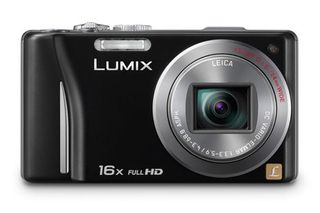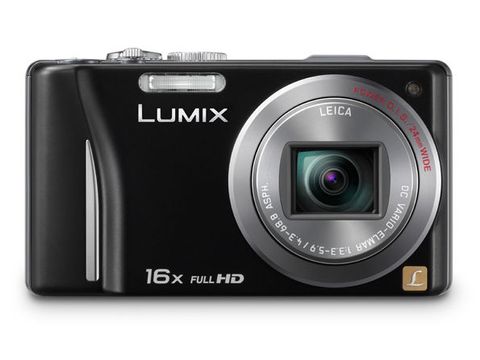Why you can trust TechRadar
Panasonic TZ20 Review: Performance
Slightly dubious of GPS functionality on cameras, my first point of call was to test the TZ20's ability to detect its location.
Setting the GPS is perfectly easy to do through the main menu system, and as I wandered around the streets of Bath I was genuinely surprised at its ability to tell me, for instance, when I had left the Southgate Shopping Centre and was closest to the Roman Baths.
In use, the TZ20 is fast. From turning on the power switch, the Panasonic TZ20 took just two seconds before it was ready to take a picture, and it met the same ultra-fast standard in between frames showing very little shutter lag.
Navigating its menus and making selections also proved very fluid. Only on entering playback mode and trying to scroll through or delete an image did I find moments of noticeable lag, but this was only a minor annoyance.
Testing its auto modes in a range of lighting conditions, the TZ20's auto white balance (AWB) mode captured realistic whites in nearly every instance – so much so that I was confident later in testing to leave the camera in AWB.
Only in low mixed lighting did AWB struggle somewhat, producing slightly orange-ish tones. Setting the white balance to tungsten didn't help the problem, so I had to set it manually in these instances.

Having used a number of Panasonic's travel zoom series compacts over the years, I was genuinely impressed by the TZ20's metering system.
Often, it seems compact cameras produce overly bright images at the sacrifice of highlight detail – particularly in skies – but the TZ20's metering system proved very reliable. Skies maintained sufficient detail thanks to the TZ20's dynamic range, with only a slight overexposure in bright conditions.
The TZ20 produced punchy pictures with nice contrast and vivid colours on the bright, spring days it was tested, and in overcast and lower light conditions it maintained its rich colour reproduction.
I noted some purple fringing in the highlight areas of some pictures taken on those bright, spring days, but it was only upon close inspection and far within the realm of what you should expect from a compact camera.
Likewise, image quality proved consistent throughout the Panasonic TZ20's large focal range, only resorting to some barrel distortion at the widest end.
An expanded range of exposure controls proved very useful, as well. In manual mode (the Panasonic TZ20 exposure modes include PASM, Intelligent Auto, 3D Photo and 30 scene modes) one is able to choose shutter speeds from 60 to 1/4000sec and set an aperture of f/3.3 to f/6.3 at the widest end of the focal range, or f/5.9 to f/6.3 at 384mm.
To do this, just press the Exposure button on the back of the camera. A menu then pops up displaying the available aperture and shutter speed settings, which one can flip between and scroll through. Though the narrow range of apertures available still felt slightly restrictive, overall this was a nice feature that was very quick and easy to use.
Support for raw capture would be a very welcome addition on any future TZ20 replacement (are you listening, Panasonic?) and is probably the only thing keeping such a rugged, capable all-rounder like this from joining the upper echelon of premium compact cameras.
Nevertheless, it's not a huge complaint. The TZ20 has plenty of other features going for it. Its Intelligent Resolution function, for instance, can digitally expand the TZ20's 16x zoom ratio up to 21x, and in our test I noticed minimal loss in quality.
AF also proved very fast and accurate with the Panasonic TZ20, even in low light. I brought the camera into a very dark storage closet and pushed the ISO ISO to 1600, and the TZ20 AF system still managed to find the boiler switch and cable on the wall for which I was composing.
What's more, in Panasonic's Intelligent Auto mode you can use the touchscreen LCD to simply press your subject, locking the AF on its target. The AF will then track the subject as it moves.
Of course, those with big hands my find their thumb accidently presses the LCD when composing, resetting the AF, which could be an annoyance. But it didn't happen to me, and if it did it's not a whole lot of effort to touch the LCD again in the correct place.
Also, when using Intelligent Auto, you can touch the subject on the LCD screen and the TZ20 will determine the correct scene mode to use by determining whether your subject is a face (Portrait mode), for instance, or a flower (Macro mode). I didn't think it would work, but it did. Every time.

The TZ20 offers a wide variety of scene modes to choose from compared to past Panasonic TZ models; however, a number of these feel gimmicky.
For example, a mode that creates fun-house mirror effects in stretching your subject wider or taller was interesting in practice, but I failed to see how it would ever warrant a second use. Likewise, a Pinhole mode had me intrigued, but its effect was a strange vignetting without the softness of a true pinhole image.
Perhaps the biggest gimmick of all, though, might be the Panasonic TZ20 3D mode. By selecting this option, pressing the shutter and then panning the TZ20 10cm left to right, the camera takes a sequence of exposures with which it makes a 3D image. If you have a 3D TV, that is. I don't. And I know no one who does – yet, at least.
This feature may very well be more accessible in future, but research (and sales) have shown 3D has yet to catch on. Saving production costs by using the CMOS sensor, rather than the CCD sensor of the Panasonic TZ10, may mean we get extra features like this but it doesn't mean we need everything - at least all at once!
Another (sort of) criticism follows the Panasonic TZ20 HDR mode. While Panasonic deserves kudos for designing a camera that produces subtle HDR images, they are perhaps too subtle.
Did I really just say that? It's true. I found the colour reproduction and exposure quality of the TZ20 so good in standard record mode that I preferred these images to their high dynamic range counterparts when shooting in tricky light conditions.
Even colours shot using Intelligent Auto mode, for instance, seemed heavier and more pleasing than those captured using its HDR function, which seemed slightly washed out. And while shadow areas retained more detail using the HDR mode, I didn't find any discernable improvements in the highlight areas.
It's also worth mentioning the Panasonic TZ20's upgrade to 1080p HD video recording after several successive models that shot at 720p. The aforementioned one-touch button on the top of the camera made filming incredibly easy, and the TZ20 offers two formats – AVCHD or Motion JPEG, but full HD video recording is only possible in AVCHD format.
You can also take still images while recording video, but be warned you are restricted to the 16:9 aspect ration and a maximum resolution of just 3.5 megapixels.
In terms of upgrades, though, playback mode is when the Panasonic TZ20's main innovation, it's touchscreen interface, really started to shine. The ability to track your subject using the 1-area AF function simply by pressing the LCD is very nice indeed, but ultimately not necessary.
The touchscreen's ability, however, to scroll through your images in playback mode with a simple swipe of the finger is a very easy and efficient way of viewing your work that I found instantly appealing. And by pressing any spot on the image I could zoom in and quickly check for sharpness or fringing.
Like most compact cameras, the Panasonic TZ20 produces sharp, clear images at its lower sensitivities, but as you creep higher into the ISO range, the image quality starts to break down.
As someone who generally doesn't mind a bit of noise and is comfortable shooting at higher sensitivities, ISO 800 was about the threshold at which I felt comfortable shooting with the Panasonic TZ20 before resorting to flash.
Indoors at dusk, in moderately low lighting, I could shoot sans flash at ISO 800 and get reasonably sharp images with acceptable amounts of noise, but above this the noise becomes distracting (as you will see on the following page). Really, ISO 400 is probably the line in the sand if you have no tolerance for noise.
Overall, I was impressed by the TZ20's image quality - and this is what counts in the end, despite how many scene modes or other features you have at your disposal.
For a camera with such a massive focal range and small enough to slide into your back pocket (just), the Panasonic TZ20 consistently captured sharp images with strong colours that required little post-processing.
Viewed at actual pixels, images did start to show traces of smudging as you creep up the ISO and focal ranges, but no more than expected, and no worse than its competitors. One could easily take the TZ20 on holiday and feel confident in making large prints from your images.
Current page: Panasonic TZ20 Review: Performance
Prev Page Panasonic TZ20 Review: Build quality and handling Next Page Panasonic TZ20 Review: Image quality and resolution
